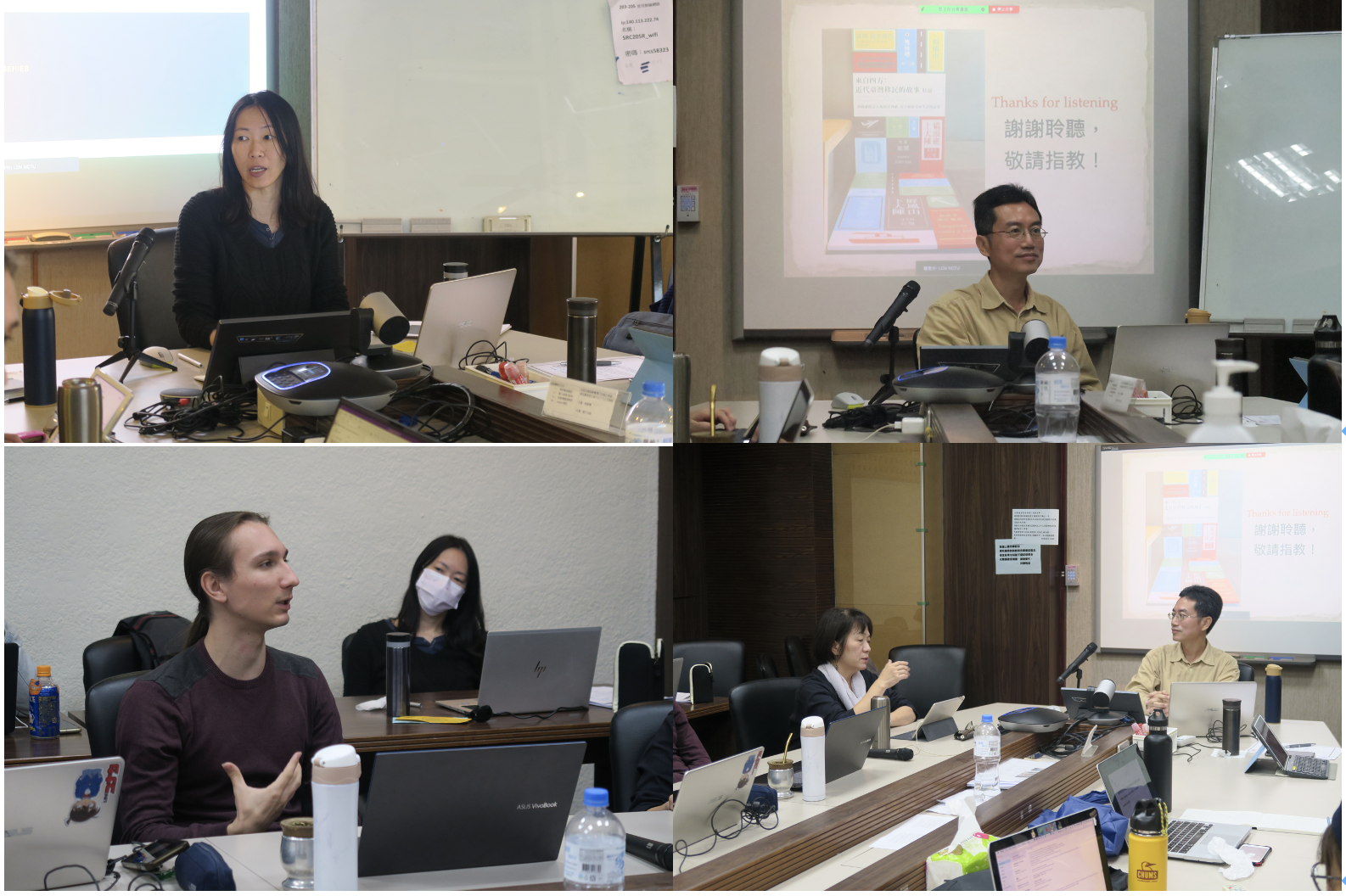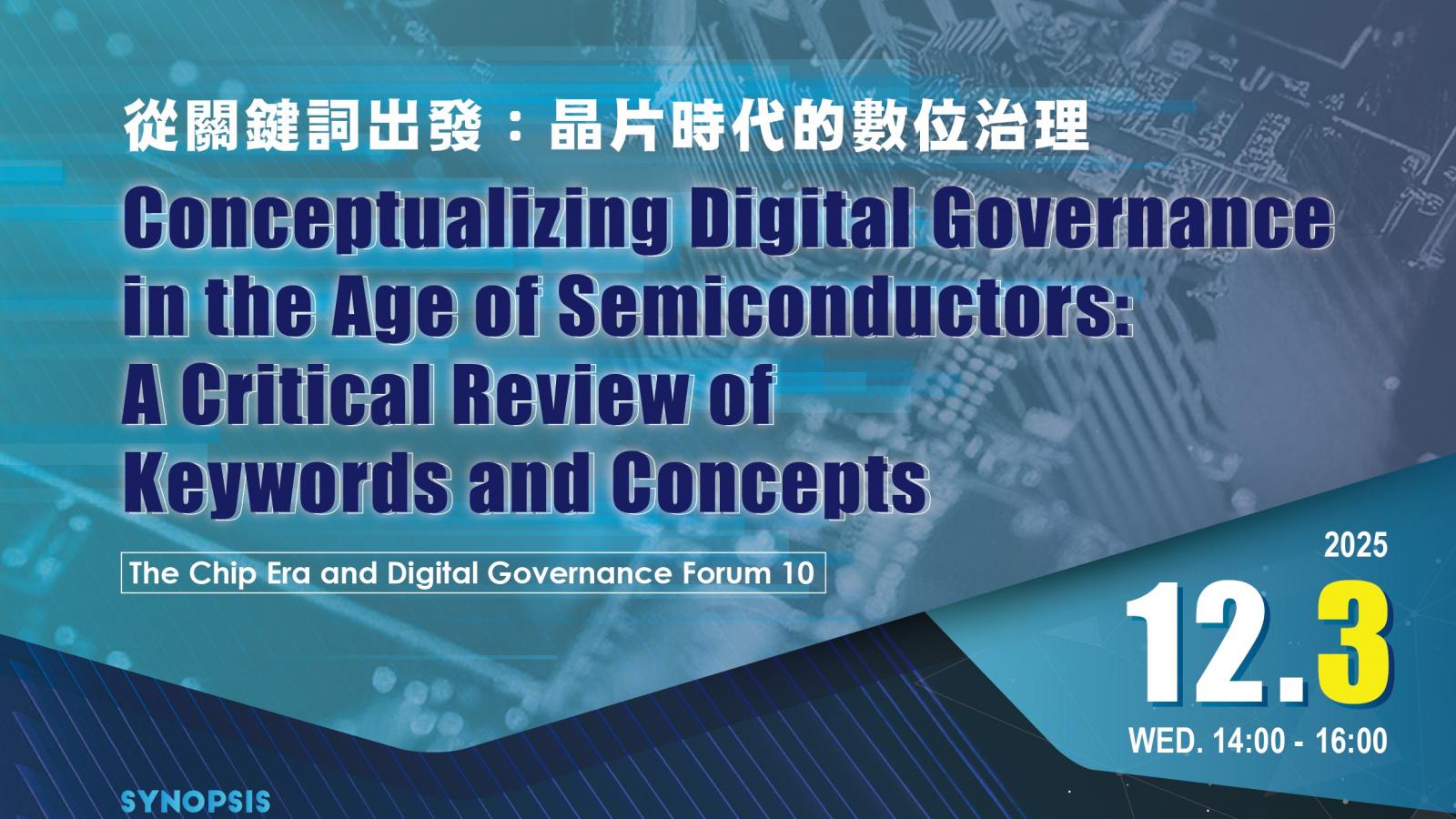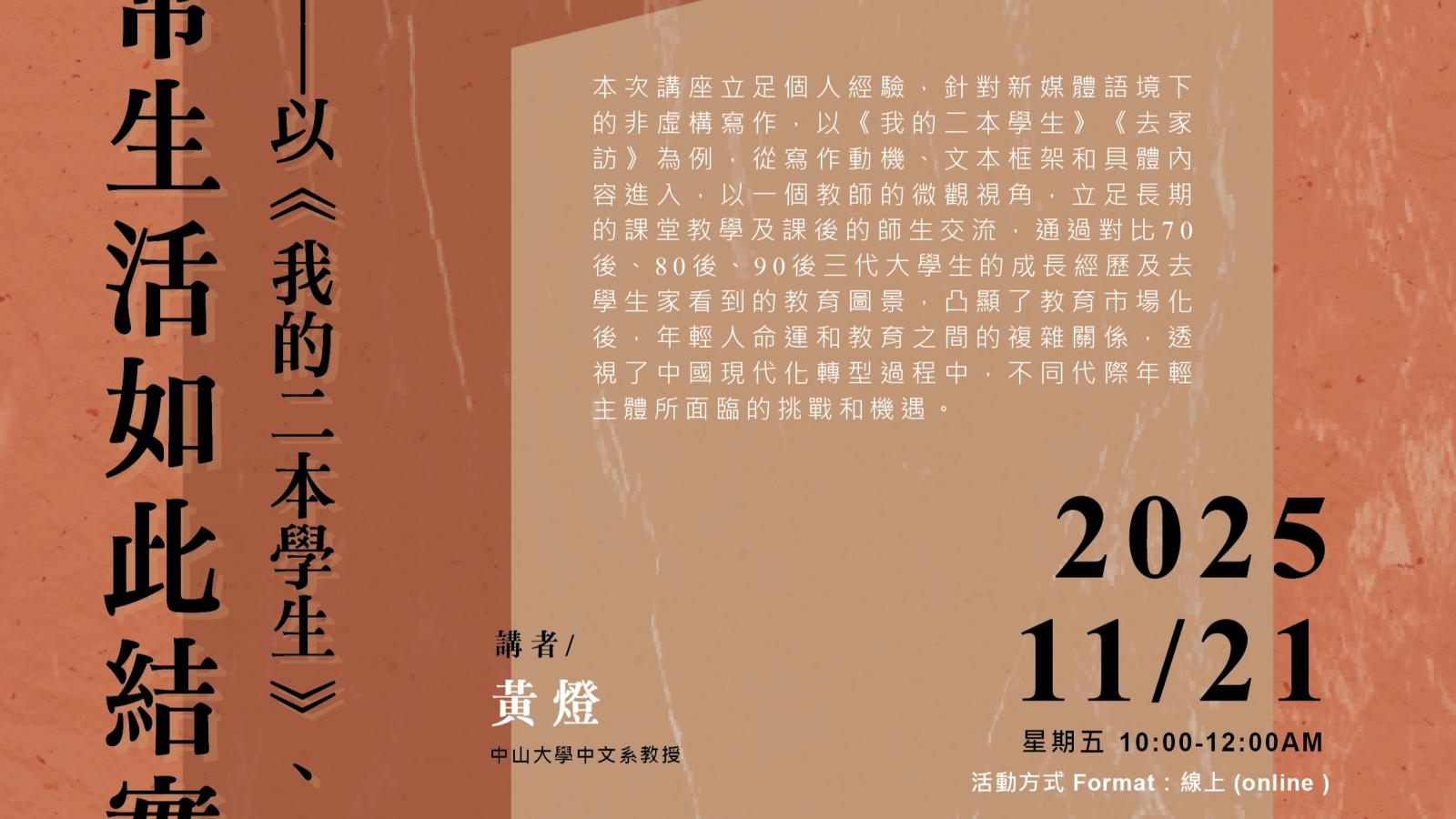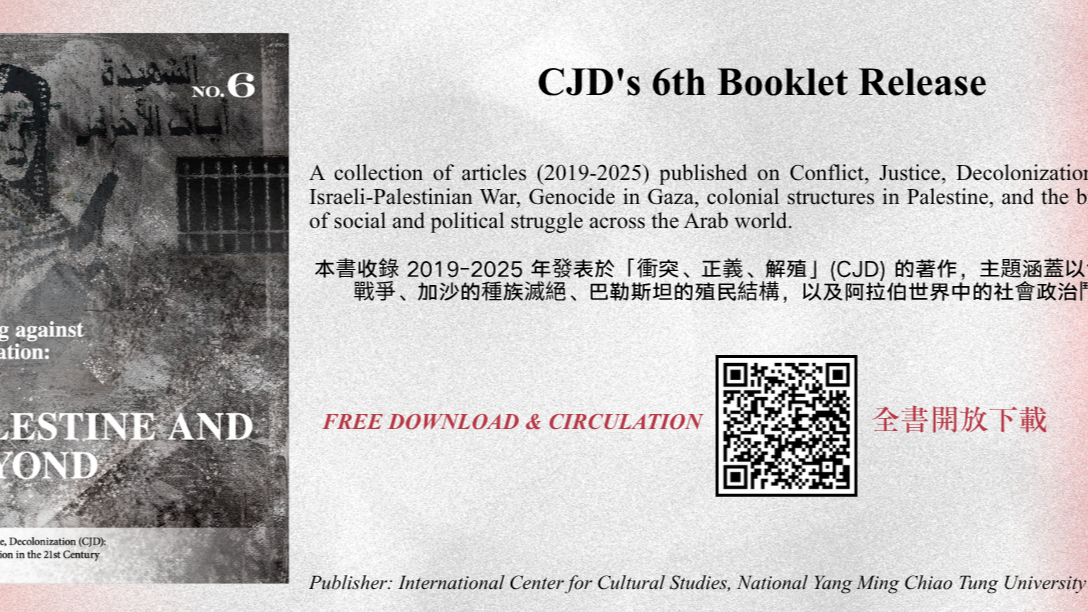

側記:2020 秋台聯大亞際文化研究演講系列 PART II
2021-04-28
側記:2020 秋台聯大亞際文化研究演講系列 PART II
< Lecture 3 >2020-12-8
如何思考亞際社會女性主義的社會工程想像?
How to envision the feminist social engineering imaginaries?
【《天義》與《她鄉》:女性主義的社會工程想像】
"Natural Justice" and "Herland" - Feminist Social Engineering Imaginaries
Speaker: Jen-Peng Liu 劉人鵬 (NTHU) & Naifei Ding 丁乃非 (NCU)
×文字記錄:胡麗蕊(Justina) /陽交大亞際學程碩士生

The topic of this week’s lecture “Feminist Social Engineering Imaginaries”, we had Professor Jen-Peng Liu from National Tsinghua University and Professor Naifei Ding from National Central University with us to discuss the vision for imagined community and social movements initiated by feminists from across different borders. The two lectures by Professor Liu and Professor Ding both emanated a strong sense of solidarity regardless of race and gender from their explorations in literature.
Professor Liu’s investigation focused on the short-lived publication Natural Justice & Equity (《天義.衡報》) that was circulated between 1907 and 1908 in China. Since the new version of the publication recently published in 2016, it had been offering new insights for scholars to their studies of feminism and social movements in China. For Liu’s research, her discussion centered around the works by feminist and anarchist He Zhen (also known as He-Yin Zhen), who was an active role during the early 20th century in China and had published significant works and political statements in Natural Justice & Equity. Before Natural Justice & Equity was established, Anarchism in China was beginning to thrive through the circulation of small booklets between 1902 and 1904. Followed by the booklets’ circulation, anti-imperialism and anti-colonialism began to emerge in different “weak” regions. It was already a revolutionary time imbued with Anti-Manchu sentiment when He Zhen published her statement “On the Question of Women’s Liberation“ (《女子解放問題》) in 1907 through Natural Justice & Equity. Liu remarked that it was essential to understand the political sentiment at the time to fully gauge the intention and position of the writer. Besides from He Zhen’s advocacy in gender equality and women’s economic independence, through the new findings of He Zhen’s works in recent years, Liu pointed out that He Zhen intended to align groups with socialist thoughts, to push forward the notion of non-nation-state in weaker regions, and possibly to align with groups that also advocated similar socialist thoughts in the U.S.. In He Zhen’s statement “On the Question of Women’s Liberation“, one of the most important ideas He advocated was her notion of Nüzi (女子).
Professor Liu highlighted that He’s choice of word Nüzi was rather different from modern discourses from the West at the time. In fact, He’s notion of Nüzi and the assertion in her writings, unlike Western discourses, were not to elicit a body politics based on the subjectivity of women’s bodies. On the contrary, He configured women’s subjugation and inequality with class struggle by aligning social injustice with a historical trajectory. He’s discourses avoided her argument reduced to discussing gendered (weak)bodies and managed to make dialogues with Anarchism. In order to break the rigid chains of enslavement by the capitalists, as Professor Liu suggested through her reflexive studies of He Zhen, the liberation of women/Nüzi must take into account that reform in the state’s economic system is needed, thus, all social movements should work together to call for a collectivity, instead of isolating one and other.
Our second speaker Professor Naifei Ding also called for such collectivity from her reflexive studies of the American feminist writer Charlotte Perkins Gilman. In Ding’s investigation of Gilman’s book Herland, she found similarities with some of the He Zhen’s advocacy and political thoughts. Written in 1915, Herland is a utopian novel about a society formed by only women. Interestingly, in Gilman’s Herlandian vision, people in the story are portrayed as species instead of race. Similar to He’s notion of Nüzi, both writers’ approach in women’s domestic suffrage delineated a class consciousness that transcends discourses of gendered/biological bodies.
Apart from writing, Gilman attended socialist experimental collective with women from middle and lower class and had done a great ideal in social reforms. Ding continued to remark some of the activist work by Gilman to highlight the realist aspect in Gilman’s literary work. It is because of that strong political demand for economic change, Ding argued Gilman’s work also consisted of realist ideals while being a utopian novel. By quoting “Economics, Evolution, and Feminism in Charlotte Perkins Gilman’s Utopian Fiction” (2010) and “Writing Feminist Genealogy: Charlotte Perkins Gilman and the Reproduction of Racial Nationalism” (2004) from two critics Chang Li-Wen and Alys Eve Weinbaum respectively, Ding reasserted Gilman’s advocacy similar to He Zhen’s: they both contested maternal skills as natural skills given to a “woman”, promoted the role of “caregiver” to transform a family structure that serves the patriarchy and ultimately change the marital dynamics.
By paralleling the works of these two pioneering feminists, Ding pointed out Gilman and He both emphasized economic independence for women and their vision in combining feminist movements with systematic economic reform. Examining the revolutionary context of these feminists in this lecture, the dialogues between Professor Liu and Professor Ding through their scholarly work had certainly evoked a more inclusive narrative regarding to class, race and feminist/gender studies.
如何理解台灣、中國及其外的記憶政治?How to understand the politics of memory in Taiwan, China and Beyond?
【國族模型與移民再現:不同國家移民博物館的社群建構指向】National Model and Representation of Migration: The Orientation of Community Reconstruction Manifested by Migration Museums in Different Countries
陳瑞樺 Chen, Jui-Hua (Institue of Sociology, NTHU)
【歷史現場?常民保存與修復地方】History on Site?: Vernacular Preservation and Fixing Urban Places in Kaohsiung
許瀞文 Hsu, Ching-Wen(Dept. Of Anthropology, NTHU)
×文字記錄:江紫爍(Cyris) /陽交大社會與文化研究所碩士生

On December 15th, 2020, the third lecture by invited speakers from the UST Clusters continued with the topic of “How to understand the politics of memory in Taiwan, China and Beyond?”. This lecture was also divided into two parts, by two different speakers, professor Chen, Jui-Hua and professor Hsu, Ching-Wen, on the issue of how to rebuild and rephase the politics of memory in different directions.
Professor Chen, Jui-Hua, from National Tsing Hua University, presented his research about “National Model and Representation of Migration: The Orientation of Community Reconstruction Manifested by Migration Museums in Different Countries”. Then he went to make a brief explanation of the idea and historical background of immigration museum.
The immigration museum first appeared during the cold war era in the 1980s as a practice of multiculturalism. It is an interesting finding that the number of immigration museums are more than the others. Those immigration museums exist, both in the provinces having a long history of emigration and in the country’s capital, but not for the international immigration, it is about the internal immigration in China. It is the linkage for establishing connection with overseas Chinese as the bridge for projecting Chinese influences under globalization.
There are 10 immigration museums established in settler’s countries in the west, and around 20 immigration museums were built in China after the 1990s. Those emigration histories as a niche for developing tourism name cards of a city and cultivating patriotism. At the same time, China used it as a bridge for projecting Chinese influences from the rest of the world. Ethnic groups create competition and make priority; immigration museums tell the story about the relationships between different ethnic groups and how they were living together under cosmopolitanism.
The purpose and the initial motivation of building up immigration museum is not to serve as a governance institution for ameliorating immigration relations, but it is trying to present the country immigration history and preserve the immigration memory of its citizens through the preservation of the historical building.
Actually, the history of immigration in China or in Southeast Asia is a rather complex one. Then, how do we re-create or give up on the idea of nation when rethinking “ethnicity” for an immigration museum? Is it a reconceptualization of a nation-state and visualized at an immigration museum?
For Professor Chen, the exhibition of history at an immigration museum is not to persecute anyone or make judgements, it is the storytelling of those historical events. It is about the community of citizens. The project of immigration museum is based on the ideas of cosmopolitanism, humanitarianism, and the question of how to live together. Beyond the museums, they are trying to deconstruct the stereotype of immigration, remind the common experiences shared by all immigrants, reduce the exclusion and rebuild the international network of migration.
Professor Chen mentioned that we are trying to rewrite national history, but not to reinforce it. He focused on the relationships and commonalities between different ethnic groups more than the stand of the nation, which in turn reflects the definition of borders as a reflection of former history.
Professor Hsu, Ching-Wen, also from National Tsing Hua University, was the second presenter of the day. She presented her research about the urban studies “History on Site? : Vernacular Preservation and Fixing Urban Places in Kaohsiung”, particularly the Coastal line: Hama-sen.
She explained the definition of vernacular architecture, which is non-pedigree, ordinary, common, flexible, adaptive to changes, difficult to define and categorize.
Then she started to introduce the background of Hama-sen with the sentence “Escaped the bombing by American Air Force in World War II but can’t escape the city’s bulldozers.”. It called Rescue Lot Three which means Designated plaza location#3, the well-planned city in Kaohsiung during the time that Taiwan was under Japanese rule.
Urban planning is modern and embodied in everyday life. The beginning was with the Takao Railway station, the following was the commercial and administration centre of the city. Then the education system was built for the Japanese upper-class children. In that time, the residents were mainly Japanese. Only a few Taiwanese were there. After the 1990s, an integrative community building program started with the following development of railway facilities preservation. Therefore, when the professor Hsu tried to retell the story of this first modernized place in Taiwan, she mentioned that the value is high and treasurable for everyone in Taiwan also.
Therefore, under the renewed-program, they were trying to find out how to fix the city by fixing the buildings. They held different workshops for engaging the community to join in, for example, the wooden work of the building. They resurrected the traditional skills, with reconnecting the human behind. It is also about the urban archaeology, th大e heritages and the street as public space, which are what the ordinary participants needed in their daily lives. Buildings act as the platform for connecting citizens and the city, through fixed or evolved those heritages for returning them in daily usages.
Professor Hsu reinforced the main point under those studies is to find out who you are dealing with, not only the government, and not only about the market also. Those everyday practices of the community are reconstructing the colonial past: Taiwanese are Taiwan, Japan, Chinese works in Hama-sen, and how the bonding was born, and the dynamic inside.
Both two presenters are focusing on the relations of land and human, and trying to point out the importance of the politics of memory for shaping the personal and national identity.
近期新聞 Recent News



New Publication | Writing against Occupation: Palestine and Beyond (CJD Booklet No.6)
2025-11-12
more